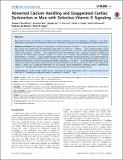| dc.contributor.author | Choudhury, Sangita | en_US |
| dc.contributor.author | Bae, Soochan | en_US |
| dc.contributor.author | Ke, Qingen | en_US |
| dc.contributor.author | Lee, Ji Yoo | en_US |
| dc.contributor.author | Singh, Sylvia S. | en_US |
| dc.contributor.author | St-Arnaud, René | en_US |
| dc.contributor.author | del Monte, Federica | en_US |
| dc.contributor.author | Kang, Peter M. | en_US |
| dc.date.accessioned | 2014-11-03T17:39:27Z | |
| dc.date.issued | 2014 | en_US |
| dc.identifier.citation | Choudhury, Sangita, Soochan Bae, Qingen Ke, Ji Yoo Lee, Sylvia S. Singh, René St-Arnaud, Federica del Monte, and Peter M. Kang. 2014. “Abnormal Calcium Handling and Exaggerated Cardiac Dysfunction in Mice with Defective Vitamin D Signaling.” PLoS ONE 9 (9): e108382. doi:10.1371/journal.pone.0108382. http://dx.doi.org/10.1371/journal.pone.0108382. | en |
| dc.identifier.issn | 1932-6203 | en |
| dc.identifier.uri | http://nrs.harvard.edu/urn-3:HUL.InstRepos:13347504 | |
| dc.description.abstract | Aim Altered vitamin D signaling is associated with cardiac dysfunction, but the pathogenic mechanism is not clearly understood. We examine the mechanism and the role of vitamin D signaling in the development of cardiac dysfunction. Methods and Results: We analyzed 1α-hydroxylase (1α-OHase) knockout (1α-OHase−/−) mice, which lack 1α-OH enzymes that convert the inactive form to hormonally active form of vitamin D. 1α-OHase−/− mice showed modest cardiac hypertrophy at baseline. Induction of pressure overload by transverse aortic constriction (TAC) demonstrated exaggerated cardiac dysfunction in 1α-OHase−/− mice compared to their WT littermates with a significant increase in fibrosis and expression of inflammatory cytokines. Analysis of calcium (Ca2+) transient demonstrated profound Ca2+ handling abnormalities in 1α-OHase−/− mouse cardiomyocytes (CMs), and treatment with paricalcitol (PC), an activated vitamin D3 analog, significantly attenuated defective Ca2+ handling in 1α-OHase−/− CMs. We further delineated the effect of vitamin D deficiency condition to TAC by first correcting the vitamin D deficiency in 1α-OHase−/− mice, followed then by either a daily maintenance dose of vitamin D or vehicle (to achieve vitamin D deficiency) at the time of sham or TAC. In mice treated with vitamin D, there was a significant attenuation of TAC-induced cardiac hypertrophy, interstitial fibrosis, inflammatory markers, Ca2+ handling abnormalities and cardiac function compared to the vehicle treated animals. Conclusions: Our results provide insight into the mechanism of cardiac dysfunction, which is associated with severely defective Ca2+ handling and defective vitamin D signaling in 1α-OHase−/− mice. | en |
| dc.language.iso | en_US | en |
| dc.publisher | Public Library of Science | en |
| dc.relation.isversionof | doi:10.1371/journal.pone.0108382 | en |
| dc.relation.hasversion | http://www.ncbi.nlm.nih.gov/pmc/articles/PMC4182450/pdf/ | en |
| dash.license | LAA | en_US |
| dc.subject | Biology and Life Sciences | en |
| dc.subject | Cell Biology | en |
| dc.subject | Medicine and Health Sciences | en |
| dc.subject | Cardiology | en |
| dc.subject | Cardiac Hypertrophy | en |
| dc.subject | Cardiovascular Diseases | en |
| dc.subject | Ejection Fraction | en |
| dc.subject | Heart Failure | en |
| dc.title | Abnormal Calcium Handling and Exaggerated Cardiac Dysfunction in Mice with Defective Vitamin D Signaling | en |
| dc.type | Journal Article | en_US |
| dc.description.version | Version of Record | en |
| dc.relation.journal | PLoS ONE | en |
| dash.depositing.author | Choudhury, Sangita | en_US |
| dc.date.available | 2014-11-03T17:39:27Z | |
| dc.identifier.doi | 10.1371/journal.pone.0108382 | * |
| dash.contributor.affiliated | Choudhury, Sangita | |
| dash.contributor.affiliated | Del Monte, Federica | |
| dash.contributor.affiliated | Ke, Qingen | |
| dash.contributor.affiliated | Bae, Soochan | |
| dash.contributor.affiliated | Kang, Peter | |


